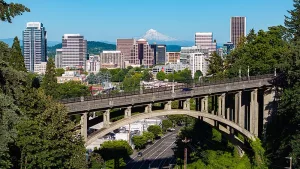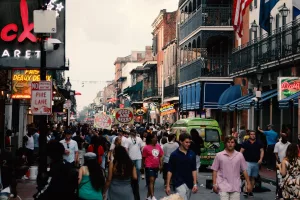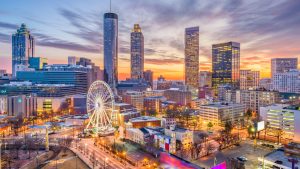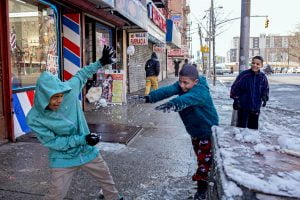Most Dangerous Neighborhoods in Portland, Oregon
Go Back To Previous PagePortland, Oregon, is a West Coast city known for its vibrant food trucks, thriving arts scene, and stunning mountain views. Despite its many attractions and booming industries, the city has developed a troubling reputation regarding crime and safety. We will go over the most Dangerous Neighborhoods in Portland!
As of 2024, Portland’s crime rate is 171% higher than the national average, with homelessness becoming an increasingly pressing issue. If you plan to visit or relocate to the city, you must know the most dangerous neighborhoods to avoid. Below is a list of the twelve neighborhoods in Portland with the highest violent crime rates.
1. Lents: The Most Dangerous Neighborhood in Portland
Lents isPortland’se most dangerous neighborhood. Located in the southeast part of the city, it is a vibrant area filled with bars, restaurants, movie theaters, and shops. It features several green spaces, including Lents Park, Beggars Tick Wildlife Refuge, and Pickles-Walker Stadium, home of the Portland Pickles baseball team.
It features several green spaces, including Lents Park, Beggars Tick Wildlife Refuge, and Pickles-Walker Stadium, home of the Portland Pickles baseball team.
However, Lents also faces significant challenges, including high crime rates, declining property values, and homelessness. The total crime rate in Lents is 10,018 incidents per 100,000 residents, 42% higher than the rest of Portland and 331% above the national average.
The violent crime statistics are particularly alarming, being 188% higher than the national average. Residents have a 1 in 10 chance of being victims of a reported crime in this neighborhood.
2. Hazlewood: The Second Most Dangerous Neighborhood in Portland
This city is one of the most dangerous neighborhoods in Portland. Hazlewood is the second largest neighborhood in the city, covering 2,500 acres in the eastern part of Portland. The Hazlewood community features tree-lined streets, spacious homes, and public green spaces such as Ventura Park and the Glendoveer Nature Exercise Trails.
However, it also has a high crime rate and one of the highest rates of shooting deaths, with seven reported in 2022 and three in 2021. The overall crime rate in Hazlewood is 9,591 crimes per 100,000 residents, which is 36% higher than the average in Portland and 313% higher than the national average. The violent crime rate is 175% higher than that of the rest of the country, and the odds of becoming a victim of a crime in Hazlewood are 1 in 11.
3. Sunderland
Sunderland is one of the most dangerous neighborhoods in Portland. The city has a high crime rate near Columbia Boulevard and Portland International Airport. With a population of just 760, Sunderland’s crime rate is 259% above the national average.
In 2022, there were 810 reported violent crimes and 7,341 property crimes. The area is especially troubled by drug trafficking and violent crime.
4. Lloyd District
The Lloyd District is one of the most troubled neighborhoods in Portland because of crime. Situated near downtown Portland and the Broadway Bridge, this diverse area experiences significant criminal activity.
Once primarily an industrial neighborhood, the Lloyd District is quickly transitioning to a more residential area with many newly constructed shops and restaurants. Nonetheless, the crime rate in the Lloyd District remains a staggering 247% higher than the national average. Common crimes in the area include vehicle thefts, burglaries, sexual assaults, and prostitution.
5. Centennial
Centennial is often regarded as one of the least desirable neighborhoods in Portland, facing significant issues with drug trafficking, homicides, and burglaries. With a population of approximately 20,932, the total crime rate in Centennial is 234% higher than the national average.
In 2022, there were 778 violent crimes and 7,050 property crimes reported. These incidents included homicides, shootings, thefts, and widespread car thefts.
6. Powellhurst
Powellhurst is a Portland neighborhood with a crime rate 228% higher than the national average, making it one of the more dangerous areas to avoid. The prevalence of homelessness contributes to widespread property crime, drug use, and dirty conditions in the region.
Additionally, violent crime is 96% above the national average, with incidents of muggings, assaults, robberies, and occasional homicides reported.
7. Bridgeton
Bridgeton is a neighborhood along the Columbia River, directly across from Vancouver. The city is known for its significant homeless population, which has led to the establishment of numerous encampments.
Residents often express concerns about challenging conditions in these areas. Although Bridgeton has a small population of around 900, its crime rate is 211% higher than the national average. Property crime is particularly prevalent in this neighborhood, where large, unhealthy homeless encampments are common.
8. Mill Park
Mill Park is a neighborhood in East Portland known for its significant homeless population. With approximately 10,300 residents, the crime rate in Mill Park is 207% higher than the national average. In 2022, there were 715 reported violent crimes and 6,479 property crimes, according to the local police department.
These incidents included theft, drug trafficking, homicide, and muggings.
9. Parkrose
Parkrose is located between highways 205 and 84 and is known for its high property crime rate. With a population of approximately 12,000, Parkrose’s crime rate is 204% above the national average.
Like many neighborhoods in Portland, Parkrose faces challenges with homelessness and a significant illegal drug market. Residents are concerned about vehicle thefts and home burglaries. Violent crimes, such as robbery and occasional homicide, also occur in Parkrose.
10. Kenton
Kenton, located in northwest Portland, is changing but still grappling with crime. With a population of approximately 8,500, Kenton’s crime rate is 171% above the national average. Property crimes are prevalent, with car thefts, burglaries, and larceny being common occurrences.
Violent crimes such as murder, assault, and robbery also take place at similarly high rates. Although some parts of Kenton have seen revitalization, a significant homeless population remains in the neighborhood.
11. St. Johns
St. Johns is a changing neighborhood with many new stores, parks, and homes. However, several parks in the area still have issues with criminal activity. Most of the neighborhood’s crime occurs on the outskirts, with theft a common problem.
While much of the homeless population has left the area, a transient presence remains in some locations, posing challenges for the transitioning neighborhoods.
12. Chinatown
Chinatown is one of the most dangerous neighborhoods in Portland. Although it remains a popular tourist destination, visitors should exercise caution while exploring it.
Crimes such as robbery, assault, and pickpocketing are common, and many of these incidents target unsuspecting tourists. While violent crime does occur, it is not as frequent as property crime. Additionally, murder rates in Chinatown tend to increase after dark.
Conclusion:
The C—grade indicates that Portland’s crime rate is slightly higher than the average for U.S. cities. Portland ranks in the 35th percentile for safety, meaning 65% of cities are safer, while 35% are more dangerous. This analysis focuses solely on the boundaries of the Portland area.
The crime rate in Portland is approximately 43.52 incidents per 1,000 residents in a typical year. Residents generally consider the southern part of the city to be the safest area.
Your chance of becoming a victim of crime in the Portland area can be as high as 1 in 10 in central neighborhoods, while it can be as low as 1 in 46 in the southern part of the city. It is essential to refer to the section on interpreting the crime map, as comparing crime rates can be more complex.


